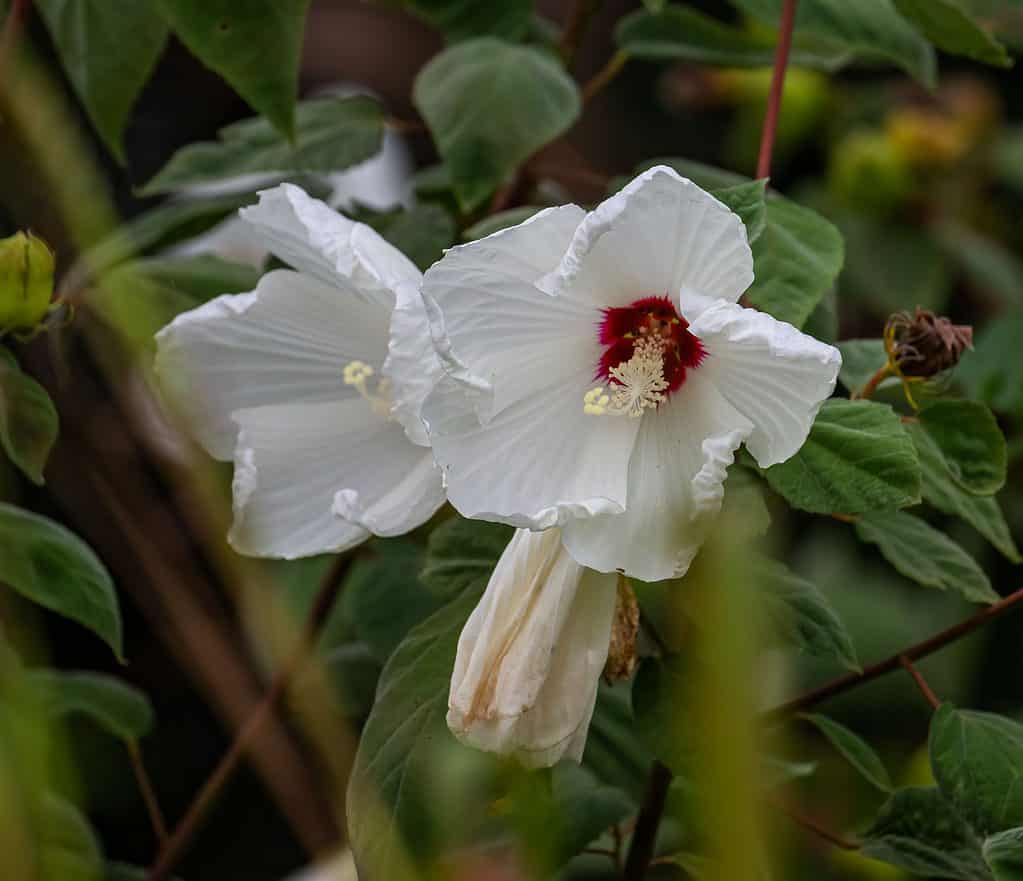Did you become smitten with the luscious hibiscus plant on a recent trip to the nursery, immediately taking it home? Or perhaps you added one to your fantastic flower garden last spring. In either case, you likely now need to know how to care for it in colder weather. We are here to help! We’ve gathered five tips for keeping hibiscus alive in the winter. Follow these, and you can enjoy the stunning blossoms next year.
What Are Hibiscus Plants?
Perennial hibiscus (Hibiscus syriacus, H. moscheutos, H. coccineus) plants are very popular for a good reason! These stunning tropical plants belong to the Malvaceae (mallow) family. They are well-known for their sizable blossoms. Some varieties even produce blooms up to 12 inches wide. The beautiful flower colors include red, pink, purple, multi-colored, white, and blue.
Most varieties are vining plants that can reach up to a shocking eight feet tall. However, you don’t need a ton of space to have a hibiscus. A handful of dwarf varieties stop growing around two to three feet tall. And there is a wide selection of sizes between these two extremes. Hibiscus fans can also choose between trees, shrubs, and herbaceous perennials.
Regardless of which variety you choose, expect to see plenty of pollinators every year! Bees, butterflies, and hummingbirds all adore the beautiful flowers.
Hibiscus plants are cold hardy in USDA Hardiness Zones 5 to 9. Many people keep them in pots to make moving them easier. But you can also plant them directly into your garden. Keep in mind that doing so may mean you need to dig the hibiscus up and pot it for winter.

Hummingbirds and other pollinators love hibiscus flowers. They flock to this tropical plant every year.
©Bonnie Taylor Barry/Shutterstock.com
5 Tips for Keeping Hibiscus Alive in the Winter
Thankfully, keeping hibiscus alive in the winter is not difficult. It only requires a few specific tips and tricks.
1. Bring Your Hibiscus Inside
While hibiscus can tolerate a range of temperatures, it will not survive when exposed to temperatures below 50 degrees Fahrenheit (10 degrees Celsius) for extended periods. But that doesn’t mean you have to avoid buying this tropical plant for your home if you live in a cold climate. There is an easy middle ground.
Bring the hibiscus plant inside once temperatures dip too low. Doing so will help ensure the delicate leaves get protected.
However, before you do so, you will want to prepare the plant for more protected life. Take a few moments to prune it back. You can safely remove up to a quarter of the plant without causing long-term harm. Focus on new growth to avoid stunting its growth. Next, you just have to bring the pot inside!

Prune any dead or dying parts of the hibiscus plant before bringing it inside over winter.
©Wirestock Creators/Shutterstock.com
2. Find a Bright Spot
Remember that hibiscus is a tropical plant that needs ample light. Find a nice, sunny, and bright location in your home for the potted hibiscus. You may wonder about the quality and amount of natural light during the winter, which makes sense. Most winter days are shorter, and the sunlight isn’t always as intense. That’s OK. Your hibiscus will still need as much natural light as possible. A grow light can always help supplement on darker days.
3. Beware of Fertilizer
Like many perennials, hibiscus plants need time to rest before the next growing season. It is best practice to avoid adding fertilizer during this time period. Wait until spring before adding any additional fertilizer.
4. Watch Drafts
During the winter, many homes will experience cold drafts, particularly from open doors. However, they also can experience bursts of hot air when the heater kicks on. These drastic swings in temperature will stress a hibiscus plant and may result in brown or yellow leaves. You know your home the best, so you can find a spot away from hot and cold drafts to protect your hibiscus.
5. Water Frequently
Many people already have their hibiscus plants in containers. If you are one of those, you are already familiar with its watering needs. Container plants typically require more attention to water levels since the small amount of soil dries out more quickly. The only major difference is that when the weather isn’t as toasty, the soil won’t dry out as fast. And the last thing you want to do is overwater your precious hibiscus. So, before watering, stick your finger about an inch or two into the soil. If that space is dry, feel free to water. If it’s still moist, you can hold off.
The photo featured at the top of this post is © Ramya K C/Shutterstock.com
Thank you for reading! Have some feedback for us? Contact the AZ Animals editorial team.







